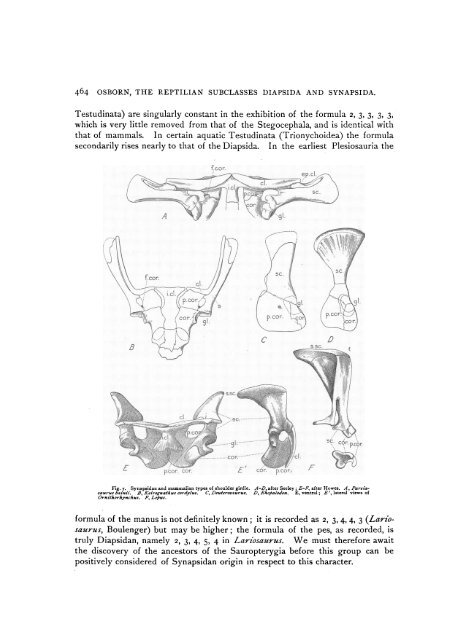American Museum of Natural History
American Museum of Natural History
American Museum of Natural History
Create successful ePaper yourself
Turn your PDF publications into a flip-book with our unique Google optimized e-Paper software.
464 OSBORN, THE REPTILIAN SUBCLASSES DIAPSIDA AND SYNAPSIDA.<br />
Testudinata) are singularly constant in the exhibition <strong>of</strong> the formula 2, 3, 3, 3, 3,<br />
which is very little removed from that <strong>of</strong> the Stegocephala, and is identical with<br />
that <strong>of</strong> mammals. In certain aquatic Testudinata (Trionychoidea) the formula<br />
secondarily rises nearly to that <strong>of</strong> the Diapsida. In the earliest Plesiosauria the<br />
S<br />
f cor.<br />
f.cor.<br />
Fig. 7. Synapsidan and mammalian types <strong>of</strong> shoulder girdle. A-D, after Seeley; E-F, after Howes. A, Pareiasaurus<br />
bainii. B, Keirogatkhus cordylus. C, Deuterosaurus. D, Rhopalodon. E, ventral; E', lateral views <strong>of</strong><br />
Ornithorhynchus. F, Leous.<br />
formula <strong>of</strong> the manus is not definitely known; it is recorded as 2, 3, 4, 4, 3 (Lariosaurus,<br />
Boulenger) but may be higher; the formula <strong>of</strong> the pes, as recorded, is<br />
truly Diapsidan, namely 2, 3, 4, 5, 4 in Lariosaurus. We must therefore await<br />
the discovery <strong>of</strong> the ancestors <strong>of</strong> the Sauropterygia before this group can be<br />
positively considered <strong>of</strong> Synapsidan origin in respect to this character.<br />
C<br />
t-<br />
DQ

















